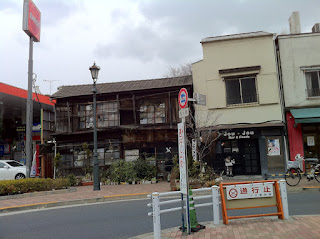Earlier this month I traveled to Tohoku with two friends and their daughters, and though there was value in our going, in a community outreach/relationship building sort of way, it was slightly embarrassing to watch volunteers head off in work boots to install floors and insulation while we were preparing to visit some ladies who make jewelry.
You have to play to your strengths, though. We weren't construction workers, we were consumers. We could spend our money in the local shops, support the local merchants, eat in local restaurants. Pump some cash into the local economy. So that's what we did, every chance we got.
Friday night we bought crackers and biscuits, soup mix and salad dressings from a miso shop run by the Takoisago family in Watanoha. They had lost many relatives, neighbors and friends in the tsunami, and were working to bring back their business. Best purchase there: a just-sweet-enough miso version of the Rice Krispie treat:

That night we ate at Chikuzen, which means "Virtuous Bamboo," also in Watanoha, and it was so good we went back on Saturday night too. It had the usual izakaya fare: katsu-don, tempura, yakitori and sashimi, all delicious. The restaurant was pretty full the first night, moderately busy the next.
Before heading up to Funakoshi to see the ladies on Saturday, we stopped in at Matsumura sports, one of the first stores to reopen in downtown Ishinomaki after March 11. They are a good source of T-shirts designed and sold expressly to raise funds for the cause. In fact, the 'It's Not Just Mud' house where we were staying had a hand-drawn map marking the store's location taped up in the breakfast room, next to some sample 'Never-Forget' themed tees hanging from the door frame. Of course we were gonna go buy some.

We found the shop well stocked with football and rugby jerseys, boots, and other gear, in addition to a full range of T-shirts. Covering the walls were photographs and notes of support and encouragement and thanks, presumably to/from neighbors and volunteers that helped clear the streets and get things going again. The ladies in the shop were super friendly and polite, digging through boxes to find our sizes and chatting with Julia who can banter a bit in Japanese.
At Homac, a big-box "home amenities" store much like The Home Depot, we picked up a dozen seat cushions to replace the thin floor coverings around INJM's dining room table.
And nobody was more excited than me to discover Eclair, a pretty French bakery surrounded by vacant lots and construction sites.

Here we loaded up on chocolate bread and almond croissants, some for Anna at INJM and some for our 5-hr return trip to Tokyo.

Read more about our trip, and It's Not Just Mud, one of many NPOs working in Ishinomaki, here.
























